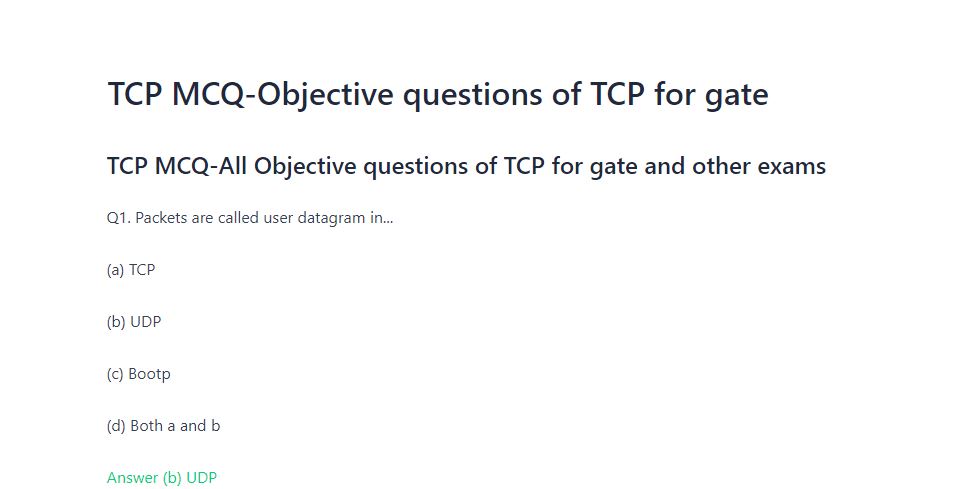
TCP MCQ
TCP MCQ-All Objective questions of TCP for gate and other exams
Q1. Packets are called user datagram in…
(a) TCP
(b) UDP
(c) Bootp
(d) Both a and b
Answer (b) UDP
Q2. Size of UDP Header in network…
(a) 8bit
(b) 8 Byte
(c) 64Byte
(d) 16bit
Answer (b) 8 Byte
Q3. Three way hand shaking are used in…
(a) TCP
(b) UDP
(c) Bootp
(d) Both a and b
Answer (a) TCP
Q4. TCP used………………… method to send segments
(a) Connection oriented
(b) Connectionless
(c) Datagram Switching
(d) Both a and b
Answer (a) Connection oriented
Q5. TCP Byte stream packets are called
(a) User Datagram
(b) Frames
(c) Segments
(d) Packets
Answer (c) Segments
Q6. Which protocol is more reliable than others…
(a) TCP
(b) UDP
(c) Bootp
(d) Both a and b
Answer (a) TCP
Q7. In TCP how to check error free data on receiver side…
(a) Piggybacking
(b) Simple Switching
(c) Acknowledgement method
(d) Both a and c
Answer (d) Both a and c
Q8. Every byte of data in TCP has a…
(a) Port number
(b) Sequence number
(c) Acknowledgement number
(d) Both a and c
Answer (b) Sequence number
Q9. Every Sequence number in TCP starts with…
(a) 1
(b) 0
(c) Any sequence number
(d) Both a and c
Answer (c) Any sequence number
Q10. In TCP every Sequence number in each segment assign to……………byte(virtual byte) of segment
(a) First
(b) Last
(c) Second
(d) Both a and c
Answer (a) First
Also Solve: Transport layer MCQs
TCP MCQ-All Objective questions of TCP for gate and other exams
Q11.TCP communication mode is…
(a) Full Duplex
(b) Simplex
(c) Half Duplex
(d) Both a and c
Answer (a) Full Duplex
Q12. In TCP sequence number that Receiver wants in the form of acknowledgement is…
(a) Next sequence number
(b) First sequence number
(c) Last sequence number
(d) Both a and c
Answer (a) Next sequence number
Q13. Calculation of checksum in TCP on transport layer is…
(a) Optional
(b) Mandatory
(c) Only for Header
(d) Both a and c
Answer (b) Mandatory
Q14. In Transport layer TCP protocol SYN flag consume………………..Sequence number .
(a) One
(b) Two
(c) Three
(d) None
Answer (a) One
Q15. In Transport layer TCP protocol SYN and ACK flag consume………………..Sequence number .
(a) One
(b) Two
(c) Three
(d) None
Answer (b) Two
Q16. In Transport layer TCP protocol if Acknowledgement not carry any data than ACK flag consume………………..Sequence number .
(a) One
(b) Two
(c) Three
(d) None
Answer (a) One
Q17. In Transport layer three way hand shaking procedure TCP protocol FIN flag consume………………..Sequence number .
(a) One
(b) Two
(c) Three
(d) None
Answer (a) One
Q18. In connection termination phase of TCP protocol FIN+ACK flag consume………………..Sequence number if no data is carry by acknowledgement.
(a) One
(b) Two
(c) Three
(d) None
Answer (a) One
Q19. A connection termination condition of TCP three way hand shaking method when sender close connection but receiver continuously send data to sender is called .
(a) Simplex mode
(b) Half Close
(c) Full Duplex
(d) None
Answer (b) Half Close
Q20. Flow control technique that TCP use in computer network are called..
(a) Sliding Window
(b) Go back n
(c) Selective repeat
(d) all of the above
Answer (d) all of the above
Also Solve: Transport layer MCQs
Q21. A problem in sliding window Protocol when a programing application sending small amount of data and receiver also send small amount of data is called…
(a) Go back n Problem
(b) Silly window syndrome Problem
(c) Count to infinity problem
(d) None of the above
Answer (b) Silly window syndrome Problem
Q22. User datagram protocol is…
(a) Not reliable and connection oriented protocol
(b) Connectionless with reliable protocol
(c) unreliable and connections less protocol
(d) None of the above
Answer (c) unreliable and connections less protocol
Q23. Silly window syndrome problem can be solve by using…
(a) Nagal’s sender side algorithm
(b) Clark’s receiver side algorithm
(c) both a and b
(d) None of the above
Answer (c) both a and b
Q24. UDP full form sound like…
(a) User datagram protocol
(b) unified datagram protocol
(c) User data protocol
(d) None of the above
Answer (a) User datagram protocol
Q25. Silly window syndrome problem solved at sender side by using…
(a) Nagal’s sender side algorithm
(b) Clark’s receiver side algorithm
(c) both a and b
(d) None of the above
Answer (a) Nagal’s sender side algorithm
Q26. Silly window syndrome problem solved at receiver side by using…
(a) Nagal’s sender side algorithm
(b) Clark’s receiver side algorithm
(c) both a and b
(d) None of the above
Answer (b) Clark’s receiver side algorithm
Q27. If Ack flag doesn’t contains any data than the number of sequence number it consumes are…
(a) One
(b) Two
(c) zero
(d) None of the above
Answer (c) zero
Q28. How many ways we can find out congestion in TCP…
(a) One way
(b) Two ways
(c) Three ways
(d) None of the above
Answer (b) Two ways
Q29. Time out timer indicate that…
(a) Congestion is Mild in Network
(b) Congestion is severe in Network
(c) Congestion is not in Network
(d) None of the above
Answer (b) congestion is severe in Network
Q30. Three duplicate acknowledgement indicate that…
(a) Congestion is Mild in Network
(b) Congestion is severe in Network
(c) Congestion is not in Network
(d) None of the above
Answer (a) Congestion is Mild in Network
Q31.After time out timer in TCP ACK flag is set to…
(a) One
(b) Two
(c) zero
(d) None of the above
Answer (d) None of the above
Q32. In TCP what is the scaling factor of header length to find out header size?
(a) Eight
(b) Sixteen
(c) Four
(d) None of the above
Answer (c) Four
Also Solve: Transport layer MCQs



3 thoughts on “TCP MCQ-Objective questions of TCP for gate”